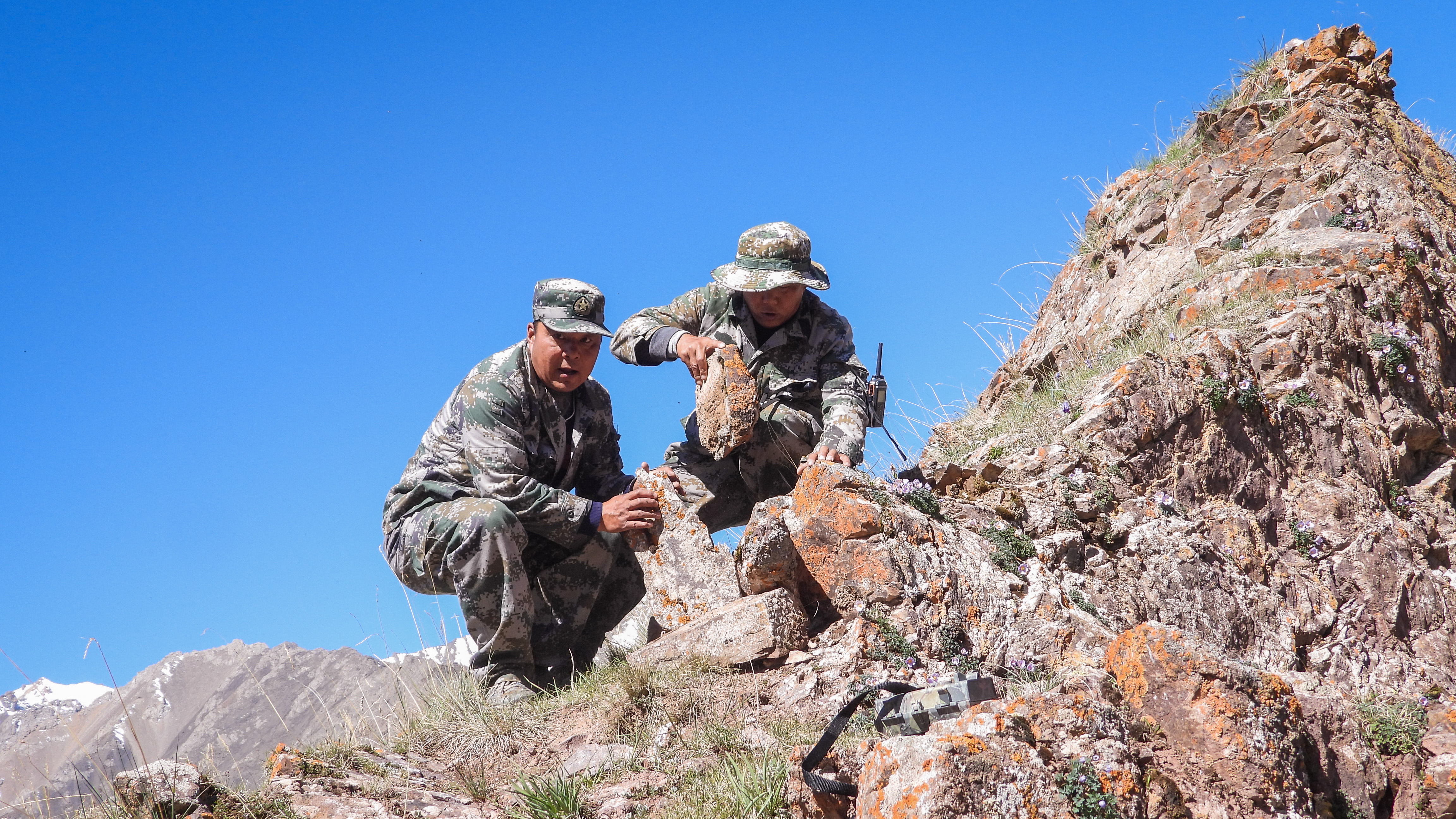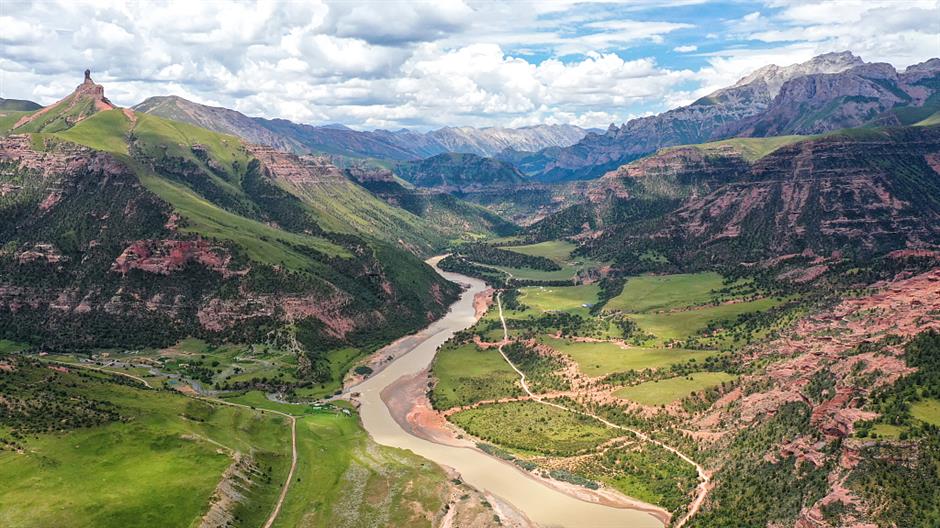Their spots don't change, but the spots where they thrive might
The habitat of the wild snow leopard in Qinghai and Gansu provinces lies along the source of three major rivers of China: the Yangtze, the Yellow River and the Lancang.
Field studies estimate there were about 5,000 snow leopards in China at the end of 2021. That's probably 22 percent more than earlier this century. However, numbers may not be accurate.
"There are no accurate statistics on snow leopard populations globally," said He Xin, senior manager of the snow leopard conservation program at the World Wildlife Fund. "We can say only that about 65 percent of wild snow leopards live in China."
The WWF has been carrying out the Global Snow Leopard and Ecosystems Protection Program since 2016. Its major goal is to assess global snow leopard populations – a first step in developing detailed protection plans.
On International Snow Leopard Day, October 23, the environmental group reported on its progress assessing populations in the Qilian Mountains of Gansu Province, another major snow leopard habitat in China. The habitat covers about 22,640 square kilometers, nearly four times the size of Shanghai.
"More than 30 rangers walked 160 routes through the mountains to record traces of snow leopards, including claw marks, footprints, urine, feces and direct sightings," He said. "One hundred sixty infrared cameras were also set up where the animals are believed to be most prevalent."

-

Staff and rangers need to conquer difficult natural environment to set up cameras and track the traces of the snow leopard, so that the population assessment could be done.
Courtesy of Zhangye Administrative Bureau of Qilian Mountain National Park -
 Courtesy of Zhangye Administrative Bureau of Qilian Mountain National Park
Courtesy of Zhangye Administrative Bureau of Qilian Mountain National Park -
 Courtesy of Zhangye Administrative Bureau of Qilian Mountain National Park
Courtesy of Zhangye Administrative Bureau of Qilian Mountain National Park -
 Courtesy of Zhangye Administrative Bureau of Qilian Mountain National Park
Courtesy of Zhangye Administrative Bureau of Qilian Mountain National Park -
 Courtesy of Zhangye Administrative Bureau of Qilian Mountain National Park
Courtesy of Zhangye Administrative Bureau of Qilian Mountain National Park
According to the WWF, the major threat to snow leopards is loss of habitat caused by climate change, poaching and the encroachment of human activities. More study is needed to determine the severity of the threats.
"The snow leopard is vital to a healthy, stable alpine ecosystem," He said. "Top predators in an area control the population of herbivores to protect meadows, thus reducing water and soil loss. After all, their home is an area providing water for one-third of the world's population. That's why we call them 'guardians of snow mountains.'"
Ciding is optimistic.
"I believe that we shepherd photographers can provide more material for scientific research," he said. "I do feel that we are seeing more snow leopards than before. Maybe that's because hunting the cats has been prohibited. That's a very good thing."

Wildlife photographer Xi Zhinong calls it a "blessing" to find wild snow leopard cubs, not to mention capturing them on the camera.
Wildlife photographer Xi Zhinong is no stranger to the "Valley of the Cats" in northwestern China's Qinghai Province.
A sanctuary in a deep valley there is home to several species of big cats, including the stunning snow leopard.
The leopard, also known as the "king of snow mountains," is one of Xi's favorite subjects. Its snowy fur is studded with black spots. The leopard has a powerful body, but the physiology of its throat prevents it from producing the bloodcurdling roar of other big cats. Instead, the leopard's "voice" is a non-aggressive puffing sound called a "chuff," which is somewhat like a soft meow.

Xi Zhinong (left) often accompanies local photographers on field trips to help them capture wildlife.
The snow leopard is listed as "vulnerable" on the International Union for the Conservation of Nature's Red List of Threatened Species.
"To common people, the sense of protecting wildlife or plants comes from familiarity," said Xi. "When they see and appreciate their beauty, they will pay attention to them and be willing to take action to protect them. That's where photography comes in."
Born in Yunnan Province in 1964, Xi has devoted his life in photographing wildlife. His vivid photos bring the world of endangered animals to the public eye. His subjects have included Yunnan snub-nosed monkeys and Tibetan antelopes.
Xi didn't see a snow leopard until 2016, and that was unexpected.
"At the time, I was photographing in the Namsei Valley in Qinghai, and I saw a snow leopard flash swiftly by," he said. "The moment was gone in seconds, before I could get my camera ready. I didn't manage to capture a snow leopard in my lens until two years later."

The Namsei Valley in Qinghai Province, nicknamed "Valley of the Cats," is a haven to the felines who roam among the waters that feed multiple major rivers in China.
For Xi and other wildlife photographers, the snow leopard is a sort of ultimate challenge. Mainly distributed in northwestern China and 12 Central Asian countries, the big cat is elusive. It generally lives on plateaus 4,000-5,000 meters above sea level. The leopard's coloring is an environmental camouflage, and the cats move extremely quickly.
Tibetan shepherds who graze sheep on the high plateaus are more used to spotting them. They act as de facto wildlife rangers, recording what they see.
Ciding is one of the Tibetan shepherds.
The 29-year-old saw his first snow leopard in 2011 and was sorry he didn't have a camera to capture the moment. Two years later, he bought a pocket digital camera and wandered in the mountains for days, looking for the leopard. He encountered none.
"Then one evening, when I was about to return home, I saw a leopard stalking a blue sheep," he said. "It approached with stealth. I got my camera ready. In the end, it failed to catch its prey, and my photos weren't very good either. I didn't have good equipment or photographic skills."

Wildlife photographer Ciding (right), with Tibetan compatriots Dajie (left) and Gengqiu Qupeng
Xi was envious of Ciding's experience, when he heard about it.
"I always believed that it would be a blessing to see a snow leopard, much less capture one on film," he said.
Xi decided that the best way to photograph leopards was to enlist the skills of local people. If these young Tibetans were provided with better equipment and proper training, they could become valuable additions to the cause of wildlife protection.
In 2016, Xi launched a training program for some of the shepherds. Ciding was one of the first to join. Today, some 40 shepherds and their families are participating.
Xi often accompanied them on photographing treks. They camped in the mountains, recording sweet skunks, hares, hawks and blue sheep with their cameras. What impressed Xi most was the reverence and respect the Tibetans had for wildlife.
"Once during a photo trip, our tent collapsed under heavy snow, and when one of the photographers was removing the snow, he saw a tiny spider on it," Xi said. "I watched as he held the spider carefully in his hands moved it to a safe place. Such a small action moved me a lot."

-

Nicknamed "King of the snow mountain," the snow leopard is much fiercer than it looks.
Imaginechina -
 Imaginechina
Imaginechina -
 Imaginechina
Imaginechina -
 Imaginechina
Imaginechina -
 Imaginechina
Imaginechina
The shepherd photographers were skillful in tracking snow leopards. One of them was the first one in China to capture the cats' mating process. In 2019, Xi was with a group that managed to record the raising of a cub.
"We happened to find a lair where a mother was raising her newborn," Xi said. "I thought the mother would move once we had spotted her, but she stayed put. We managed to take photos of mother and cub for next 35 days. The mother definitely knew we were there, but she somehow accepted us. Or, should I say, she tolerated us."
In 2020, Xi and the shepherd photographers held an exhibition in Shanghai, which attracted widespread public attention, for the shepherds as well as the snow leopard.

A snow leopard at the "Big Cat Valley." The cats can be difficult to spot because of their natural camouflage.
















